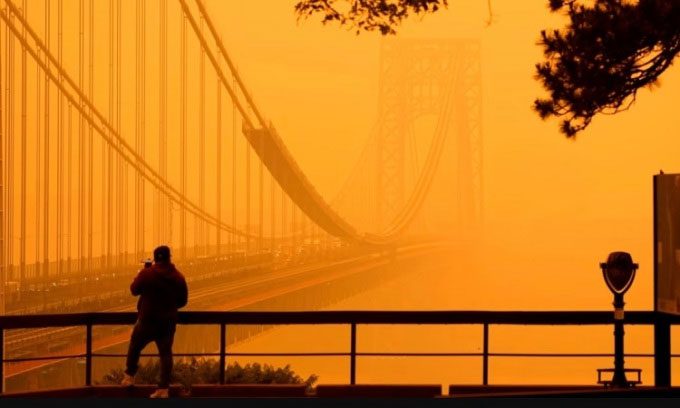Smoke from raging wildfires in Canada spreads across cities in North America, forcing residents to stay indoors.

George Washington Bridge in New York engulfed in smoke. (Photo: AP).
Dense smoke from wildfires in Canada is enveloping the air quality across North America, disrupting everything from air travel to public events. Authorities issued health warnings to millions of residents in the eastern United States and Canada on June 7, as a cloud of smoke from hundreds of wildfires moved southward, covering densely populated areas from Ottawa to Washington, D.C. In New York City, the air quality on June 7 was reported to be the worst among major cities worldwide, surpassing even New Delhi, India, according to IQAir’s air quality index.
While wildfire-related air pollution has become a frequent issue along the western coast of the United States in recent years, this situation is much less common on the east coast. Many residents were alarmed as the sky unexpectedly turned a hazy orange, prompting them to wear masks. Schools in New York and Washington had to cancel outdoor activities, while U.S. aviation authorities postponed flights to Philadelphia, Newark, New Jersey, and LaGuardia Airport due to poor visibility. The hazardous air quality in New York also forced some Broadway artists to cancel performances.
Smoke obscured many iconic landmarks, including the Statue of Liberty and Yankee Stadium. Eric Adams, the mayor of New York, urged residents to stay indoors and keep windows closed in the coming days. Even if conditions improve in the next few days, Adams emphasized that such scenes could be repeated in the future due to climate change.
Canada is grappling with a wildfire season, with blazes reported in nearly 10 provinces over the past month. Canada’s environmental manager classified air quality in the capital, Ottawa, at the highest health risk level. Many regions in Quebec and Ontario are also under air quality warnings. As of June 7, over 400 wildfires were active across Canada, with approximately 4 million hectares of land burned since the beginning of the year.
Scientists have observed an increase in wildfires in the Northern Hemisphere over the past decade, with average temperatures rising faster than in equatorial regions due to global warming. May 2023 became the second hottest May on record, according to the European Union’s Copernicus program.



















































